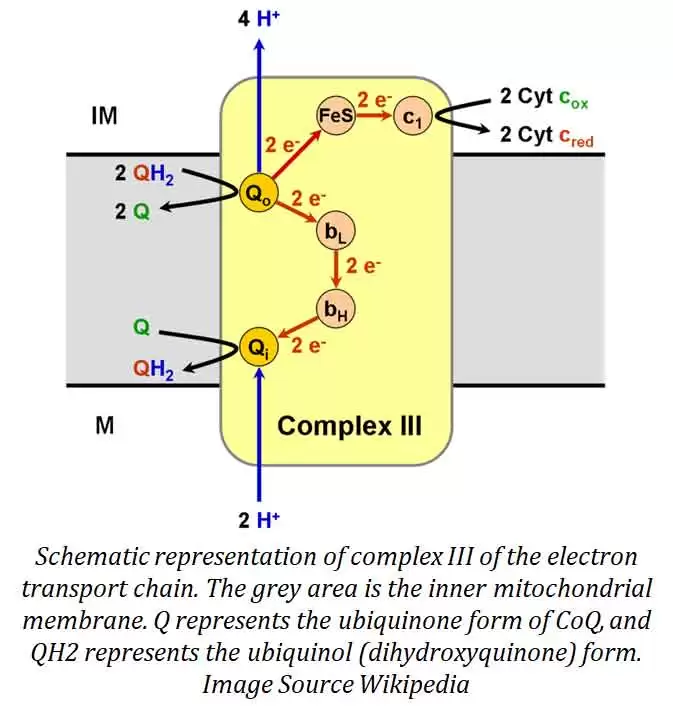What is Q Cycle?: The Q cycle (short for quinol cycle) is a series of reactions in which the lipophilic electron carrier Coenzyme Q (CoQ) undergoes sequential oxidation and reduction between its ubiquinol and ubiquinone forms, leading to the net movement of protons across a lipid bilayer in the inner mitochondrial membrane. Q cycle is a fundamental process associated with the mitochondrial inner membrane’s complex III of Electron Transport System (ETS). The Q cycle is pivotal for efficient electron transfer and proton pumping, ultimately contributing to the generation of a proton gradient that drives ATP synthesis in the cell. Understanding the Q cycle sheds light on the intricate mechanisms of cellular respiration and energy production. This article discusses the concept of Q cycle and the role of Q Cycle in Electron Transport Chain.
What is Electron Transport System?
Ø Cellular respiration involves the conversion of biochemical energy from nutrients into ATP (energy currency of the cell)
Ø This process occurs in the mitochondria and consists of three main stages (1). glycolysis, (2). Krebs cycle, and (3). Electron Transport Chain.
Ø The ETC is composed of four protein complexes (named as complex I-IV) that facilitate electron transfer from electron donors like NADH and FADH2 to the final electron acceptor – oxygen.
Ø This transfer process releases energy, which is used to pump protons across the inner mitochondrial membrane, creating a proton gradient.
Ø The Q cycle plays a critical role in this process, particularly in the complex III of the ETS.
Complex III and the Role of the Q Cycle
Ø The complex III of ETS is also known as the cytochrome bc1 complex.
Ø It is essential for transferring electrons from ubiquinol (QH2) to cytochrome c.
Ø The Q cycle describes the mechanism by which complex III achieves this transfer while simultaneously pumping protons from the mitochondrial matrix into the intermembrane space, contributing to the proton gradient.
Mechanism of the Q Cycle
Ø The Q cycle operates in two stages, each involving distinct steps of electron transfer and proton translocation:
First Half of the Q Cycle
Ø Ubiquinol (QH2), a reduced form of coenzyme Q (ubiquinone), binds to the Qo site of complex III.
Ø QH2 releases two electrons: one electron is transferred to the Rieske iron-sulphur protein and then to cytochrome c1, ultimately reducing cytochrome c.
Ø This electron transfer is coupled with the release of two protons into the intermembrane space.
Ø The second electron from QH2 is transferred to cytochrome b, then to ubiquinone (Q) at the Qi site, forming a semiquinone radical (Q•-).
| You may also like NOTES in... | ||
|---|---|---|
| BOTANY | BIOCHEMISTRY | MOL. BIOLOGY |
| ZOOLOGY | MICROBIOLOGY | BIOSTATISTICS |
| ECOLOGY | IMMUNOLOGY | BIOTECHNOLOGY |
| GENETICS | EMBRYOLOGY | PHYSIOLOGY |
| EVOLUTION | BIOPHYSICS | BIOINFORMATICS |
Ø After the transfer of both electrons, the ubiquinone molecule at the Qo site becomes oxidized and is released back into the inner mitochondrial membrane.
Second Half of the Q Cycle
Ø A second molecule of QH2 binds to the Qo site and undergoes a similar process: one electron reduces another cytochrome c, and two more protons are released into the intermembrane space.
Ø The second electron again travels to the Qi site, where it completes the reduction of the semiquinone radical (Q•-) to ubiquinol (QH2).
Ø This regenerated QH2 is released into the inner mitochondrial membrane.
Proton Pumping and ATP Synthesis
Ø The Q cycle effectively doubles the proton pumping efficiency of complex III.
Ø For every two electrons transferred from QH2 to cytochrome c, four protons are pumped into the intermembrane space—two from the matrix and two released from QH2.
Ø This proton translocation contributes significantly to the proton motive force (PMF), which is the driving force for ATP synthesis by ATP synthase.
Biological Significance of the Q Cycle
Ø The Q cycle is crucial for maximizing the efficiency of the electron transport chain.
Ø By ensuring the transfer of electrons from QH2 to cytochrome c while pumping protons across the membrane, the Q cycle enhances the proton gradient needed for ATP production.
Ø This process is vital for cellular energy metabolism and overall cellular function.
Summary: The Q cycle is a sophisticated mechanism that plays a central role in cellular respiration. By facilitating efficient electron transfer and proton pumping within complex III, the Q cycle ensures the generation of a strong proton gradient, which is essential for ATP synthesis. Understanding the Q cycle highlights the intricacies of mitochondrial function and the elegance of biological energy conversion processes.
FAQ
What is the primary function of the Q cycle in cellular respiration?
The primary function of the Q cycle in cellular respiration is to facilitate the transfer of electrons within the electron transport chain. This process involves the oxidation and reduction of Coenzyme Q (CoQ) between its ubiquinol and ubiquinone forms. The Q cycle helps to generate a proton gradient across the inner mitochondrial membrane by moving protons from the mitochondrial matrix to the intermembrane space. This proton gradient is essential for ATP synthesis through oxidative phosphorylation.
How does the Q cycle contribute to ATP production?
The Q cycle contributes to ATP production by generating a proton gradient across the inner mitochondrial membrane. During the cycle, protons are translocated from the mitochondrial matrix to the intermembrane space, creating an electrochemical gradient. This gradient drives the synthesis of ATP as protons flow back into the matrix through ATP synthase, a process known as chemiosmosis.
Are there any diseases or disorders associated with abnormalities in the Q cycle?
Yes, abnormalities in the Q cycle can lead to mitochondrial diseases, which often result in impaired energy production. These disorders can cause symptoms such as muscle weakness, neurological problems, and organ dysfunction due to insufficient ATP generation.
How is the Q cycle regulated in the cell to ensure efficient energy production?
The Q cycle is regulated through the availability of substrates such as NADH and FADH2, which supply electrons for the electron transport chain. Additionally, the activity of the Q cycle is influenced by the ADP/ATP ratio, ensuring that ATP synthesis matches the cell’s energy demands. Cellular mechanisms, such as the control of mitochondrial membrane potential and the expression of electron transport chain components, also play crucial roles in maintaining efficient energy production.
| You may also like NOTES in... | ||
|---|---|---|
| BOTANY | BIOCHEMISTRY | MOL. BIOLOGY |
| ZOOLOGY | MICROBIOLOGY | BIOSTATISTICS |
| ECOLOGY | IMMUNOLOGY | BIOTECHNOLOGY |
| GENETICS | EMBRYOLOGY | PHYSIOLOGY |
| EVOLUTION | BIOPHYSICS | BIOINFORMATICS |
| You may also like... | ||
|---|---|---|
| NOTES | QUESTION BANK | COMPETITIVE EXAMS. |
| PPTs | UNIVERSITY EXAMS | DIFFERENCE BETWEEN.. |
| MCQs | PLUS ONE BIOLOGY | NEWS & JOBS |
| MOCK TESTS | PLUS TWO BIOLOGY | PRACTICAL |





